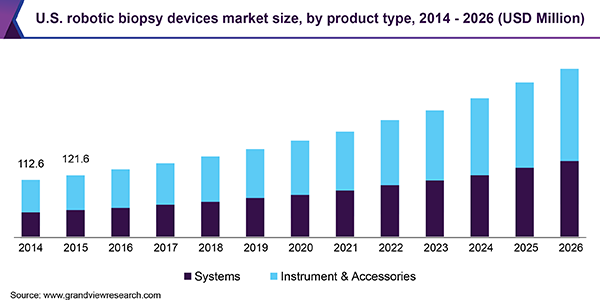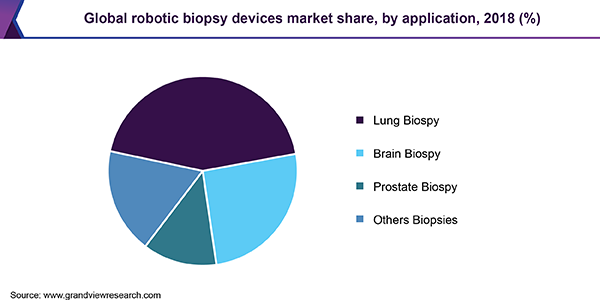- Home
- »
- Medical Devices
- »
-
Robotic Biopsy Devices Market Size, Share, Industry Report, 2019-2026GVR Report cover
![Robotic Biopsy Devices Market Size, Share & Trends Report]()
Robotic Biopsy Devices Market Size, Share & Trends Analysis Report By Product Type (Systems, Instruments & Accessories), By Application (Lung, Brain, Prostate), By Region, And Segment Forecasts, 2019 - 2026
- Report ID: GVR-4-68038-012-5
- Number of Pages: 75
- Format: Electronic (PDF)
- Historical Range: 2014 - 2017
- Industry: Healthcare
Industry Insights
The global robotic biopsy devices market size was valued at USD 302.5 million in 2018 and is anticipated to grow at a significant rate over the forecast period. Key factors accrediting to this growth are rising incidence of cancer and growing penetration of robotic systems for the diagnosis of this disease. Cancer cases are growing at a rapid rate globally. According to the Cancer Research UK, there were around 17 million new cancer cases in 2018. The most common cancer cases reported were for lung, breast, bowel, and prostate, which accounts for a total of 43% of all new cases. Moreover, it has been forecast that there will be nearly 27.5 million new cases each year by 2040.
Biopsy is one of the primary and major tests for determining the cancer stage. Image-guided tests can only detect abnormal mass growth but fail to differentiate whether the mass is cancerous or not. It can be accurately detected only by undergoing biopsy. Hence, as the global burden of cancer is increasing, the demand for these procedures to diagnose cancer is also increasing. This, in turn, is creating opportunities for robotic biopsy devices.

Moreover, the growing demand for minimally invasive procedures among patients and providers is driving the growth of the market. For instance, traditional methods of performing a prostate biopsy involve greater complications and longer hospital stays. However, by opting for robotic assisted devices, specialists can obtain targeted area samples from any part of the prostate gland with high precision and without disturbing the surrounding nerve.
The robotic approach for performing a biopsy even provides greater details on the location of the lesion. This reduces the risk of puncture damage to nearby tissues or organs. Moreover, the robot-assisted procedure requires only 2 to 3 skin punctures, regardless of the number of mass samples needed for diagnosis. There is also a minimum risk of infection involved due to less invasion and eventually leads to improved recovery for patients. This, in turn, has increased the adoption of robotic procedures over traditional approaches.
However, the lack of availability of medical professionals in developing countries, along with high setup costs required for these robotic systems may hinder market growth. Low-income countries cannot afford these expensive devices as their healthcare expenditure is lesser than the average global healthcare expenditure. Surgeries in these countries are still performed using manual instruments due to low reimbursement rates. Therefore, many cancer cases are left undiagnosed, resulting in a high cancer mortality rate in these countries.
Product Type Insights
Based on product type, the robotic biopsy devices market is classified into systems and instruments & accessories. In 2018, instruments & accessories accounted for the largest revenue share of 56.1%. This segment is experiencing unprecedented growth owing to the availability of a wide variety of biopsy instruments and accessories in the market. Moreover, as the number of biopsies increases, the number of instruments such as needles and brushes required to perform this procedure is also increasing. Each new procedure requires a new set of instruments, to reduce the risk of infection. Hence, there is a continuous sale of instruments and accessories.
However, the systems segment is anticipated to grow at the fastest rate during the forecast period. Rising number of medical device and robotics companies engaged in R&D and commercialization of medical robots is the primary factor influencing demand for robot assisted biopsy devices. These companies foresee it as a lucrative business, owing to on-going automation in healthcare and demand for minimum invasive surgeries among patients. For instance, XACT Robotics developed the XACT Robotics System, a robotic platform that performs image-guided percutaneous procedures. The product is projected to be launched by 2019 in the U.S. Many robotic devices such as Monarch Platform and Ion Endoluminal System will also be launched in the market soon.
Application Insights
The global robotic biopsy devices market, based on application, is classified into the lung, brain, prostate, and other biopsies. In 2018, lung biopsy dominated the market and is anticipated to exhibit the highest CAGR of 12.3% over the forecast period. Increasing incidence of lung cancer is a primary factor encouraging market growth. According to the American Institute for Cancer Research, approximately 2 million new cases were reported globally in 2018. Smoking is the cause of nearly 90% of the cases. Non-smokers exposed to second-hand tobacco smoke and radon gas or air pollution have also reported lung cancer.

Many suspicious lesions found in the lungs may be minor and difficult to access, which makes obtaining the sample challenging. Robot-assisted devices address this challenge by enabling surgeons to obtain tissue samples from deep within the lung with greater accuracy. Furthermore, a decrease in procedure time has ultimately led to lesser anesthetized time for patients, which eventually leads to reduced hospital costs. These advantages of robotic devices over manual procedures is further expected to drive the demand for robot-assisted biopsy devices.
Regional Insights
Based on geography, the market for robotic biopsy devices is segmented into North America, Europe, Asia Pacific, Latin America, and MEA. North America dominated the market in 2018, with a revenue of USD 175.7 million. Presence of major key players in the region, well-established healthcare infrastructure, and on-going investments on biopsy robots are some of the key factors contributing to the large share of North America.
Medical device companies in this region are continuously working on the inclusion of robotics and other technological platforms in healthcare settings for the diagnosis of cancer. For instance, in 2019, U.S. based Intuitive Surgical introduced a robotic platform Ion for minimally invasive peripheral lung biopsies. The device has been commercialized for sale in the U.S.
Moreover, California-based company Auris Health developed a flexible robotic endoscopic system named Monarch Platform. This system aims to detect lung nodules. The product has been launched only in the U.S. The commercialization of majority of robotic devices in the U.S. has also made the region a leader in robot assisted biopsy devices.
Robotic Biopsy Devices Market Share Insights
The robot-assisted biopsy device market is oligopolistic in nature. Key market participants are focusing on strategic consolidation to enhance market reach and capture a larger share. Some of the leading players are Medtronic plc, Renishaw plc, iSYS Medizintechnik GmbH, Mazor Robotics, Biobot Surgical Pte Ltd, Medrobotics, and Medtech SA. Players expected to enter the devices market include Intuitive Surgical, Auris Health, and XACT Robotics.
Report Scope
Attribute
Details
Base year for estimation
2018
Actual estimates/Historical data
2014 - 2017
Forecast period
2019 - 2026
Market representation
Revenue in USD Million and CAGR from 2018 to 2026
Regional scope
North America, Europe, Asia Pacific, Latin America, MEA
Country Scope
U.S., Canada, Germany, U.K., Spain, France, Italy, Japan, China, India, South Korea, Singapore, Australia, Mexico, Brazil, Argentina, South Africa, Saudi Arabia, UAE
Report coverage
Revenue forecast, company share, competitive landscape, growth factors, and trends
15% free customization scope (equivalent to 5 analysts working days)
If you need specific information, which is not currently within the scope of the report, we will provide it to you as a part of customization
Segments Covered in the ReportThis report forecasts revenue growth at global, regional, and country levels and provides an analysis on latest industry trends in each of the sub-segments from 2014 to 2026. For the purpose of this study, GVR has segmented the global robotic biopsy devices market report on the basis of product type, application, and region:
-
Product Type Outlook (Revenue, USD Million, 2014 - 2026)
-
Systems
-
Instrument & Accessories
-
-
Application Outlook (Revenue, USD Million, 2014 - 2026)
-
Lung Biopsy
-
Brain Biopsy
-
Prostate Biopsy
-
Other Biopsies
-
-
Regional Outlook (Revenue, USD Million, 2014 - 2026)
-
North America
-
The U.S.
-
Canada
-
-
Europe
-
Germany
-
The U.K.
-
Spain
-
France
-
Italy
-
-
Asia Pacific
-
Japan
-
China
-
India
-
South Korea
-
Singapore
-
Australia
-
-
Latin America
-
Brazil
-
Mexico
-
Argentina
-
-
MEA
-
Saudi Arabia
-
South Africa
-
UAE
-
-
Share this report with your colleague or friend.
![gvr icn]()
NEED A CUSTOM REPORT?
We can customize every report - free of charge - including purchasing stand-alone sections or country-level reports, as well as offer affordable discounts for start-ups & universities. Contact us now
![Certified Icon]()
We are GDPR and CCPA compliant! Your transaction & personal information is safe and secure. For more details, please read our privacy policy.
We are committed towards customer satisfaction, and quality service.
"The quality of research they have done for us has been excellent."





